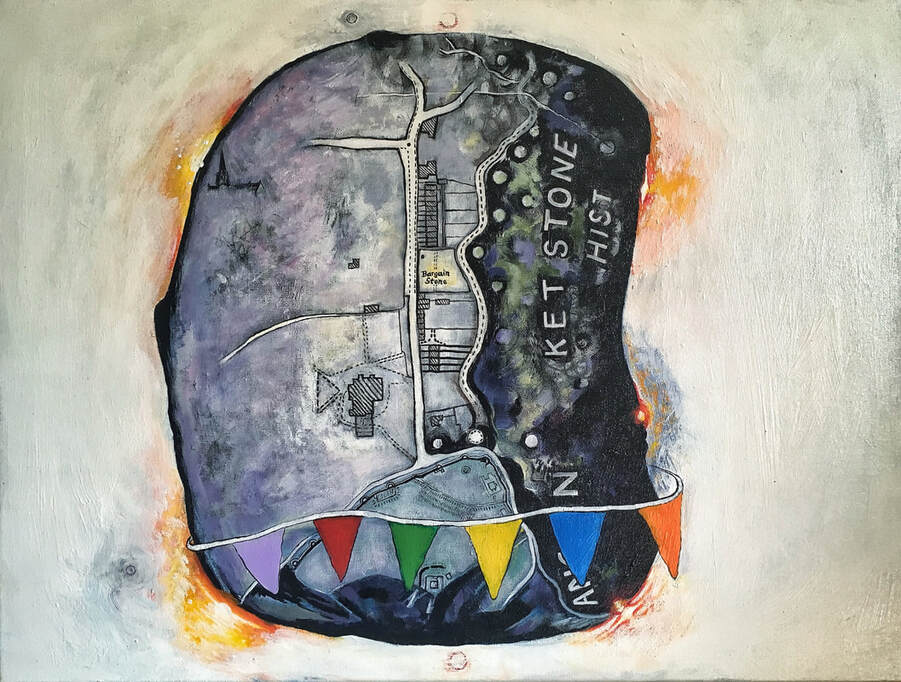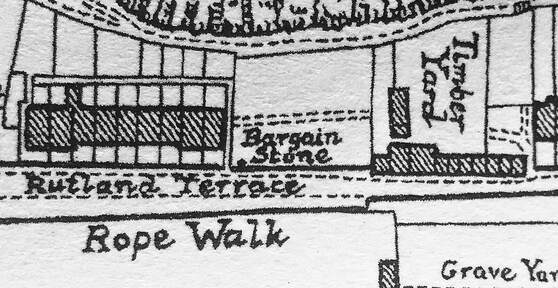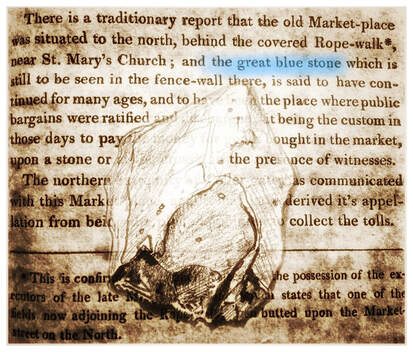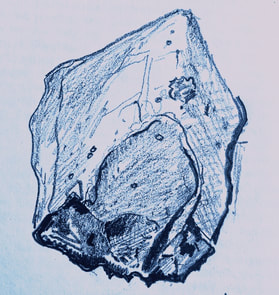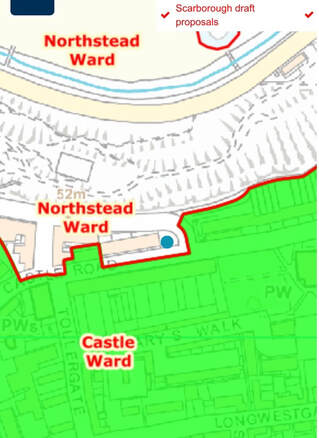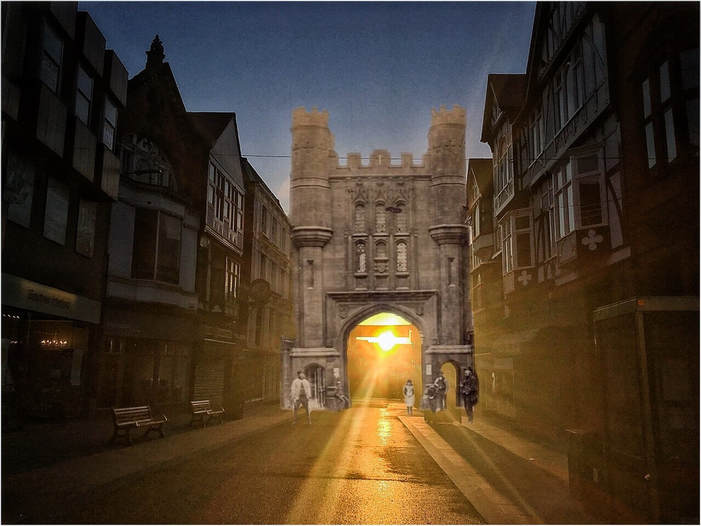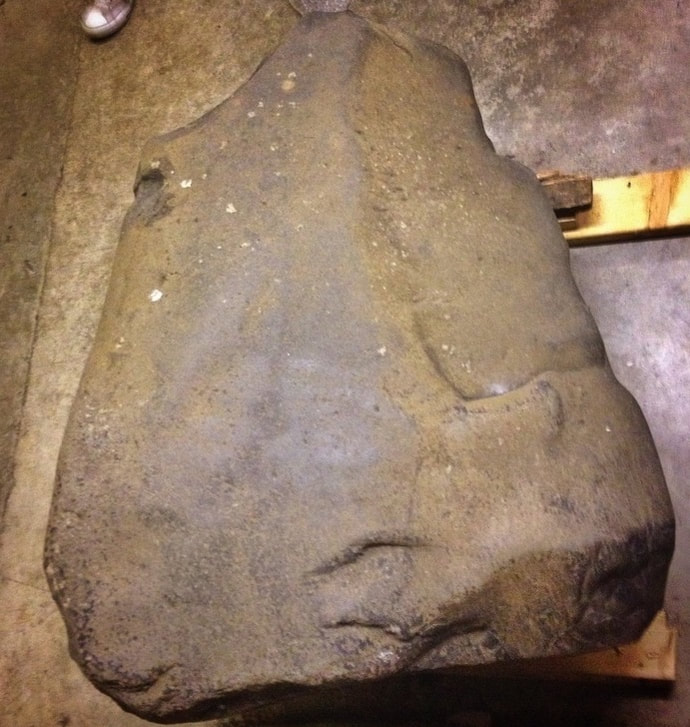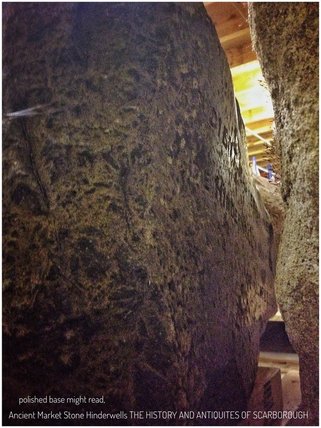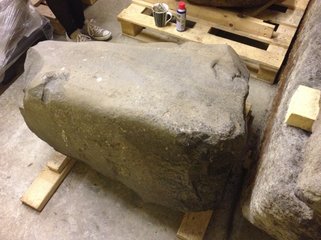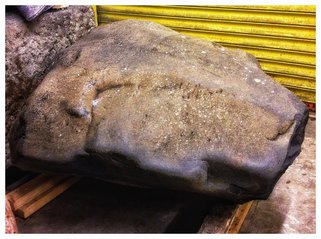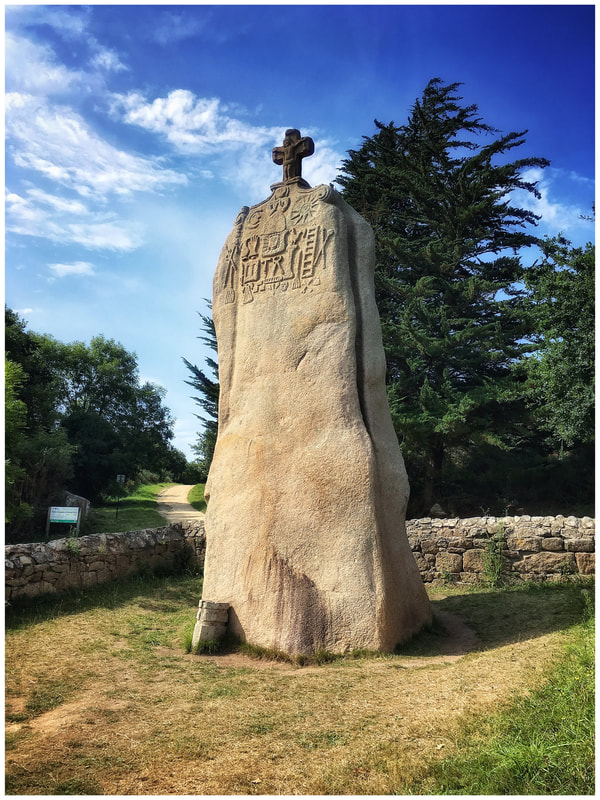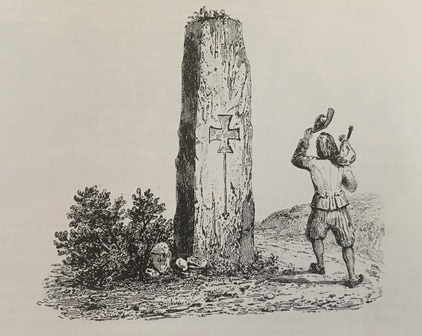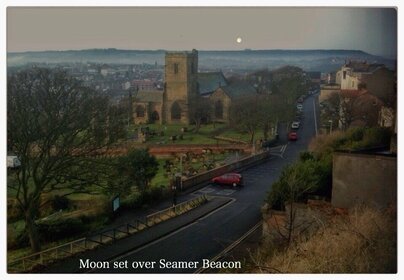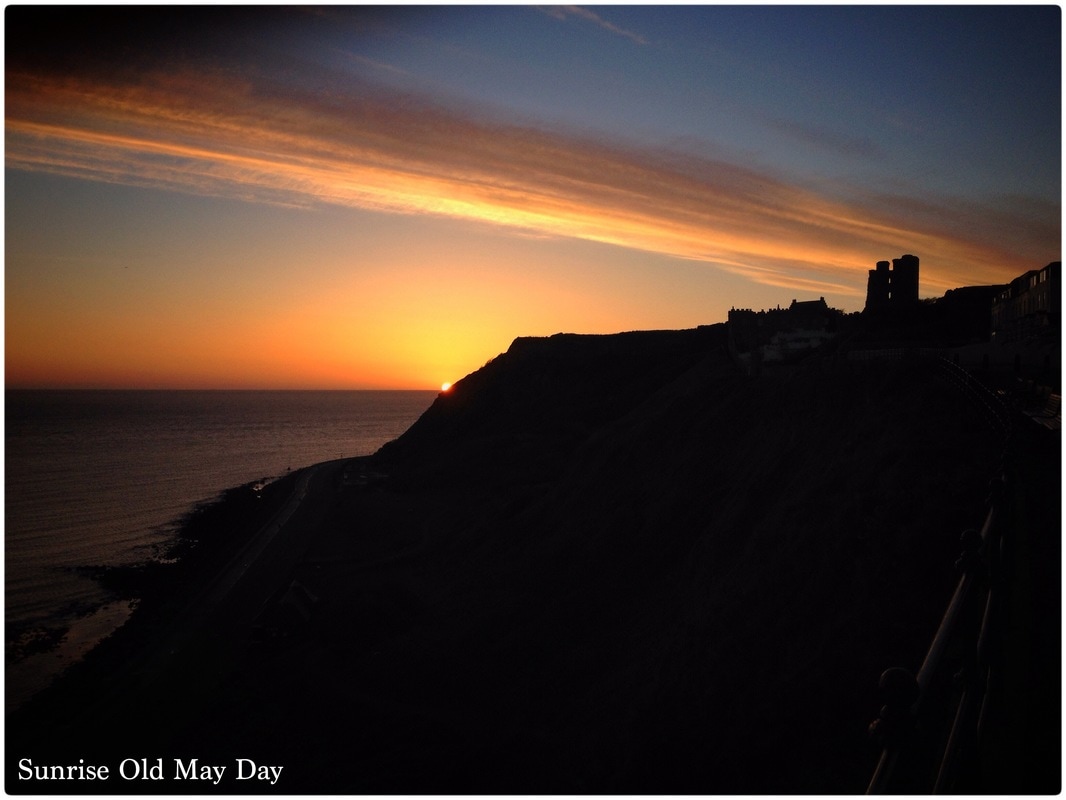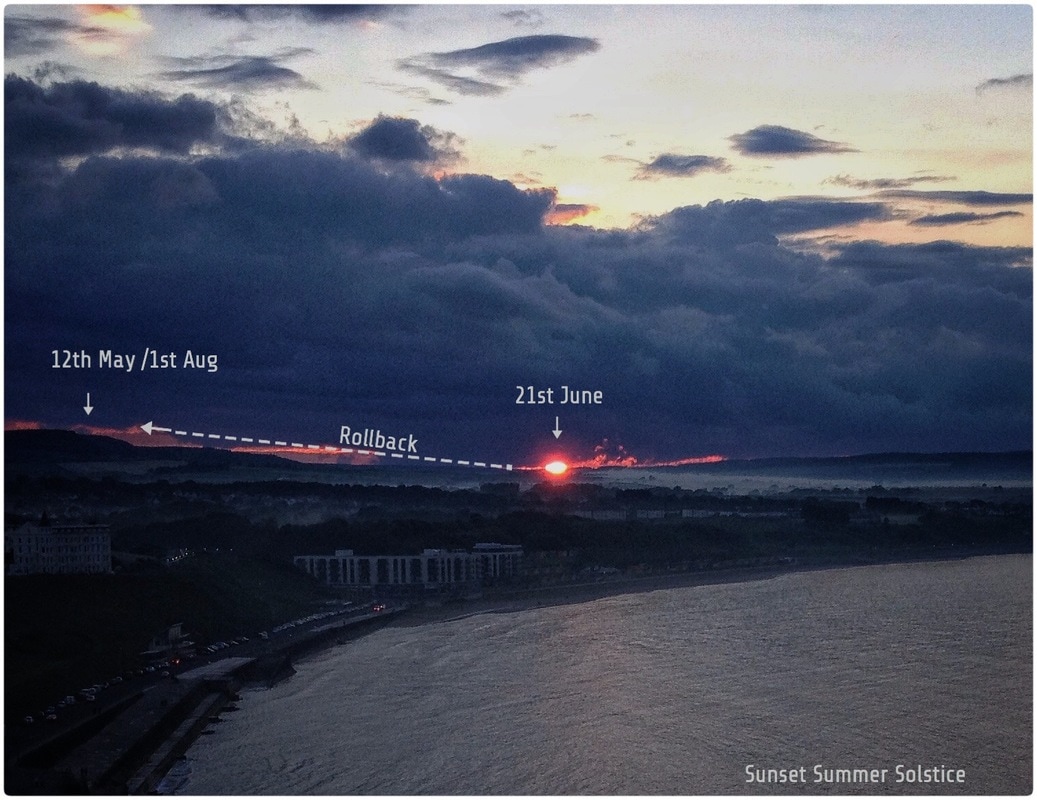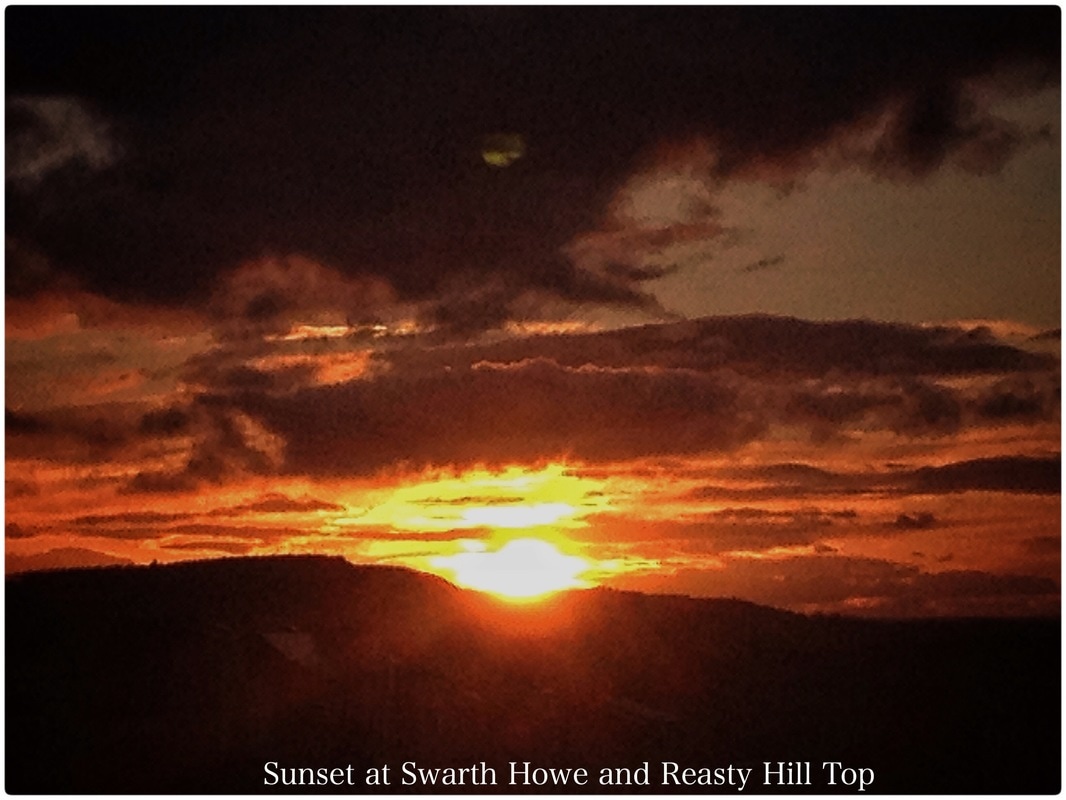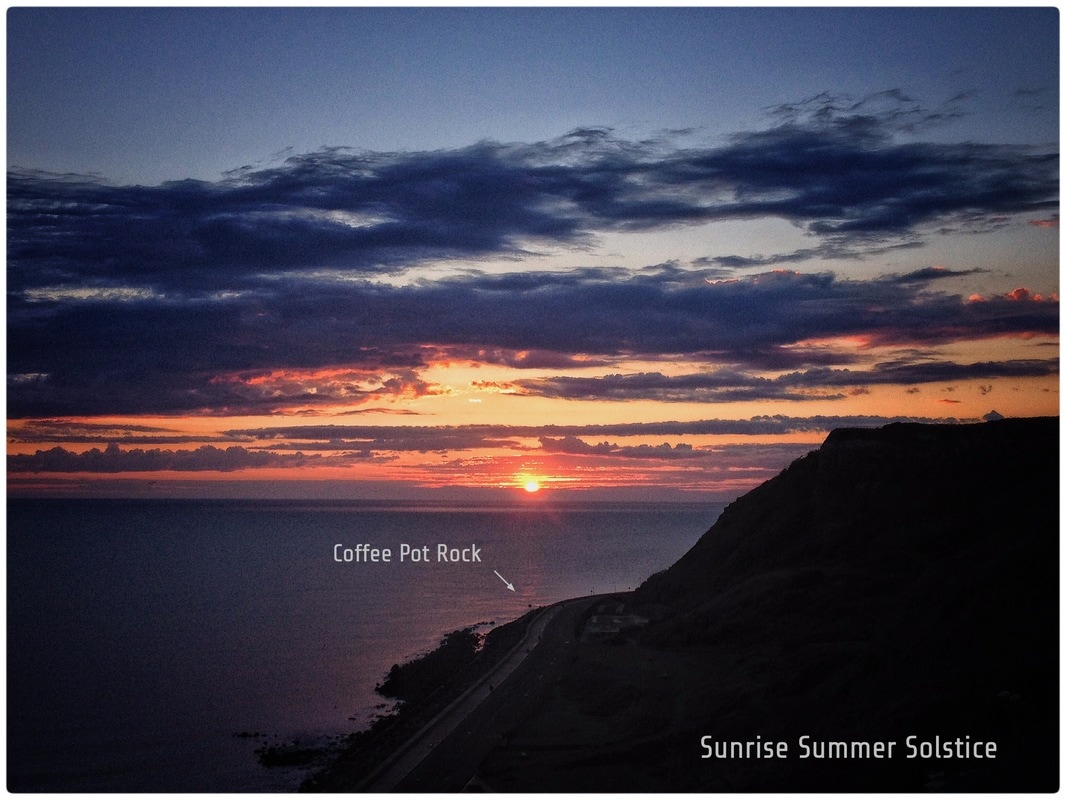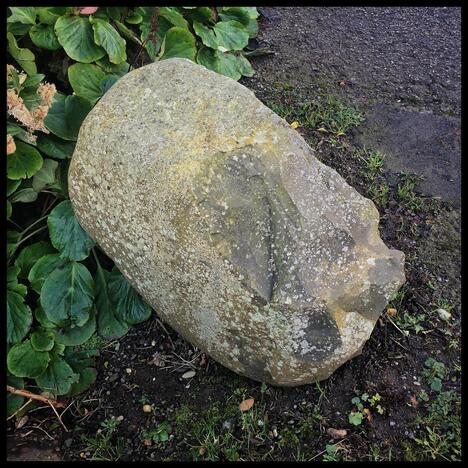Near The Great Blue Stone Revisited; travel notes and correspondence with a lump of basalt.
I wrote an article for the Scarborough Review a few years ago about Scarborough’s ancient market stone that was known as The Great Blue Stone. After reading my article a few people contacted me offering interesting information about the stone and others like it around Britain and Europe. I wanted to record as much of this information as possible but I found it difficult to link the information together. I didn’t want to leave anything out. What follows is an ongoing dialogue with a lump of basalt known as The Great Blue Stone.
Mentioned by the historian Thomas Hinderwell in his 1798 book, The History and Antiquities of Scarborough and the Vicinity. He writes, “There is a traditionary report that the old market place was situated to the north, behind the covered Rope Walk, near St Mary’s Church; and the great blue stone which is still to be seen in the fence wall there, is said to have continued for many ages to have been the place where public bargains where ratified and discharged as being the custom in those days to pay the money for goods bought in the market, upon the stone or at the cross, in the presence of witnesses.”
Scarborough’s ancient market stone stood on the approach to the gates of Scarborough Castle on what is now the car park of the Phoenix Hotel on Queens Parade. Very near to the grounds of St. Mary’s Church and the grave of Thomas Hinderwell, the stone appears on different maps and in different history books as 'The Great Blue Stone', the 'Bargaining Stone', the ‘Ancient Market Stone' and 'The Old Blue Stone'. The stone is a large piece of basalt about the size of a large leather chair. If it was a recumbent stone it was possibly flat enough to stand on, rising maybe two or three feet up above a crowded marketplace, possibly with the North or the South Bay as your theatrical backdrop, on one of Scarborough’s less windy days. From the area of land around The Great Blue Stone you would have had an elevated view of the surrounding landscape over an undeveloped town and the vicinities beyond. Specifically, Flamborough Head, Filey Brigg, White Nab, Oliver’s Mt, Weaponess, Seamer and Irton Moors (just look at Seamer Beacon!), Scalby Nabs, Silpho, Standing Stones Rigg, Cloughton and Ravenscar. A coast line and hill brows lined with Bronze Age tumuli, Earthworks and ancient history.
After the development of Castle Road in the mid 1800's, The Great Blue Stone was moved and placed in the care of the Scarborough museum where it was kept in the museum gardens. At some point it was damaged, one end has been smashed off, which makes it difficult to estimate its original size and shape. Arthur Rowntree’s, The History of Scarborough, published in 1931, mentions that the blue stone was in the care of the museum. M. Andrews, in his book, The Story of Old Scarborough published in 1947, includes a sketch of the blue stone, perhaps taken from another source rather than drawn directly from life, but the sketch clearly shows the stone as broken at the near end.
During it’s stay at the museum another end of the stone has been polished smooth revealing the fine detail of the basalt, the end carved with the words 'Ancient Market Stone', along with the name ‘Thomas Hinderwell’, which I guess was to honour the historian for his contributions to the town. Menhirs and standing stones all over Europe have been 'Christianised', where crucifixes, bible quotes or bible images have been carved onto the sides of the stone, but the great blue stone seems to have been 'antiquarian-ised'; where the name of a historian, the name of his book and his name for the stone have been carved into the stone’s base.
'Bluestone' is a word used to describe a piece of basalt and is also a word used to describe a foreign stone not intrinsic to the area. An interested correspondent from Denmark suggested that Scarborough’s market stone was likely to be a blueish cult stone, of which there are many examples in Britain and Northern Europe. Blue cult stones served as judicial stones, originally used as oath stones, mentioned in the ancient laws of the Low Countries from the 6th century. Bluestones were used in the same tradition as The Stone Of Scone (The Stone Of Destiny), kept in Edinburgh Castle. Scarborough’s bluestone isn’t so regal, but The Great Blue Stone was a focal point in old Scarborough, being the place for speakers and for making declarations, as I mentioned in my article published in the Scarborough Review, maybe the great blue stone should be kept under the Mayors Seat or with the Mayor’s chains of office at Scarborough Town Hall?
Bluestones in the Netherlands are quarried in the Ardennes. The bluestones of Stonehenge were quarried from the Preseli Hills. I personally think the Scarborough’s blue stone was originally brought to the town after being quarried from Whinstone Ridge on the North York Moors.
From its former location on Castle Rd, the Great Blue Stone’s elevated position the horizon line is filled with interesting details, made especially notable observing the rising and setting of the sun and moon at certain times of the year. The horizon north-west makes a curious shallow bowl shape from the features of Suffield Moor, Burn Howe Moor, Nettlehead and Standingstones Rigg. On different nights in summer the sun moves from one side of the bowl shape to the other, setting at different points marked by tumuli as it reaches the summer solstice. Setting at Swarth Howe and along Burn Howe Moor. 'Swarth' might have come from 'Svarti' meaning 'black' (charred) and 'Burn' Howe on Burn Moor may denote ritual fires set during this time of the year.
The sun reaches its furthest setting point at the boundary tumulus at Thirley Beck Farm on the summer solstice. I think it’s worth mentioning that the nearest source of basalt is Winstone ridge where the sun is setting at the hight of midsummer. Sunrise on the Winter Solstice occurs over Flamborough Head. Sunrise on Mayday appears in the left hand corner of the headland, appearing in the North Bay for the first time at the start of summer and appears again at the same place at the time of Lamas in August when the sun appears for the last time in the North Bay at harvest time and at the start of the beginning of Scarborough’s great fairs.
According to tradition, judicial bluestones around Europe were sited at the city gates, the reason for this is attributed to the bible which stated, ‘At the gates wisdom was uttered’ (Proverbs 1:21). Scarborough’s bluestone was sited on the roadway to the gates of Scarborough Castle, halfway between the Old Borough Gate at the top of Auborough Street close to the old borough boundary ditch. The area were the blue stone stood is still used as a ward boundary today (see map). Bluestones also marked the centre of towns at the intersection of the town wards, often at a crossing of a waterway.
What if in Scarborough’s past, prior to the stone’s location at Castle Road, as the town developed, the bluestone had been moved around like a podium and put in a central place, by a waterway or by the town gate say at Newborough or Auborough Gate, as was the custom in Europe? Scarborough’s blue stone could have been sited by the Rede Cross; one of Scarborough’s old town crosses that stood close to the centre of the old town on Longwestgate, at the corner with Springfield, near to the Damyot stream, that important Scarborough waterway? Or the bluestone could have even been in the grounds of the Church of St Thomas the Martyr by the Newborough Gate, placed near to the area where the Damyot steam enters the town? As I mentioned above, according to tradition, judicial bluestones around Europe were sited at the city gates, for 'Wisdom would be found at the gates', the reason is attributed to the bible Proverbs (1:21), ‘At the gates wisdom was uttered’. The Gate of Jerusalem marks the beginning of the path Christ took from prison to the place of crucifixion, the Via Dolorosa. This place is marked with the carving of a Black Lion. At the site of the Newborough Gate in Scarborough is The Black Lion Pub a name probably passed on through heraldry originally referring to a pilgrimage to the Holy Lands, many public houses called The Black Lion are sited near the entrance to a town or city.
It has been suggested that the stone may have originally been a glacial erratic, randomly dropped by a glacier at the end of the last ice age. It could be, but as I mentioned earlier, it’s location on Castle road seems to have been greatly considered to be dropped randomly. The word erratic is from the Latin ‘errare’ which means to wander, making an erratic a ‘wandering stone’. Some erratics where moved by glaciers or by melt water, others are moved by greater forces such as Scarborough Borough Council. Scarborough’s bluestone was moved from the fence wall on Market Gate, now Castle Road, to the grounds of Scarborough Museum, and then again into storage while the museum was undergoing repairs. Bluestones do get about a bit.
The use of Bluestones and town crosses were customs of the Vikings but not exclusive to them. Many tribes in North Europe settled in Britain and locals shared some of the same customs. There are bluestones in Scandinavia used in almost identical circumstances as Scarborough’s bluestone. With no surviving town cross from the Viking period left in Scarborough, is the blue stone the only evidence that the Vikings were living and trading in Scarborough?
I have recently come across another interesting piece lump of basalt in the Wheatcroft area, that parcel of land that belonged to Scarborough’s bailiffs and burgesses. It is a smaller piece than the great blue stone but of the same type and angular shape and has a broken section at one side. Could it be the missing end? It is located near the bridleway to White Nab near the well that served the old white washed farmstead of High Wheatcroft, that this area is named after. The smaller piece of basalt is an ornamental stone that overlooks the old town, the old market place with St Mary’s Church and the area of the Auborough Gate can be seen in plain sight.
To me, Scarborough’s bluestone is a great curiosity. Countless traders and towns people must have come into contact with it, agreeing prices for goods and for making bargains, speeches and declarations. And perhaps not just Scarborians but also those visiting the town from Europe at the time of the great fairs. The fairs attracted visitors from as far away as the Baltic, the Great Jabbler's Fayre was one of Scarborough’s big events of the year. Scarborough’s Fair even has its own song; a ballad of bargaining, challenges and impossible tasks.
Jabblers Fayre ran from Assumption Day until Michaelmas. Annunciation Day, also known as Lady Day on the 25th of March also has an interesting relationship with The Blue Stone. Lady Day is also called 'Bargaining Day' and the 'Bargaining Stone' being one of The Great Blue Stone’s other names.
Modern Scarborough was well known for 'Ladies Day' / Boxing Day and its relaxed drinking hours; Ladies Day around the country was in March around New Year in the Old English calendar. Annunciation Day is near to the Spring Equinox and the sun is aligned down Castle Road on this date; Castle Road was the original site of the great blue stone. Curiously, The Great Blue Stone seems to have close associations with the calendar dates associated with the Virgin Mary, probably because it was sited so close to the grounds of the 12th Century church of St Mary's. The Feast of the Annunciation and Feast of the Assumption are notable in Scarborough’s calendar. This heavy lump of wandering basalt seems to have soaked up lots of Early Christian and Pre-Christian Culture.
DavWhiteArt.com
I wrote an article for the Scarborough Review a few years ago about Scarborough’s ancient market stone that was known as The Great Blue Stone. After reading my article a few people contacted me offering interesting information about the stone and others like it around Britain and Europe. I wanted to record as much of this information as possible but I found it difficult to link the information together. I didn’t want to leave anything out. What follows is an ongoing dialogue with a lump of basalt known as The Great Blue Stone.
Mentioned by the historian Thomas Hinderwell in his 1798 book, The History and Antiquities of Scarborough and the Vicinity. He writes, “There is a traditionary report that the old market place was situated to the north, behind the covered Rope Walk, near St Mary’s Church; and the great blue stone which is still to be seen in the fence wall there, is said to have continued for many ages to have been the place where public bargains where ratified and discharged as being the custom in those days to pay the money for goods bought in the market, upon the stone or at the cross, in the presence of witnesses.”
Scarborough’s ancient market stone stood on the approach to the gates of Scarborough Castle on what is now the car park of the Phoenix Hotel on Queens Parade. Very near to the grounds of St. Mary’s Church and the grave of Thomas Hinderwell, the stone appears on different maps and in different history books as 'The Great Blue Stone', the 'Bargaining Stone', the ‘Ancient Market Stone' and 'The Old Blue Stone'. The stone is a large piece of basalt about the size of a large leather chair. If it was a recumbent stone it was possibly flat enough to stand on, rising maybe two or three feet up above a crowded marketplace, possibly with the North or the South Bay as your theatrical backdrop, on one of Scarborough’s less windy days. From the area of land around The Great Blue Stone you would have had an elevated view of the surrounding landscape over an undeveloped town and the vicinities beyond. Specifically, Flamborough Head, Filey Brigg, White Nab, Oliver’s Mt, Weaponess, Seamer and Irton Moors (just look at Seamer Beacon!), Scalby Nabs, Silpho, Standing Stones Rigg, Cloughton and Ravenscar. A coast line and hill brows lined with Bronze Age tumuli, Earthworks and ancient history.
After the development of Castle Road in the mid 1800's, The Great Blue Stone was moved and placed in the care of the Scarborough museum where it was kept in the museum gardens. At some point it was damaged, one end has been smashed off, which makes it difficult to estimate its original size and shape. Arthur Rowntree’s, The History of Scarborough, published in 1931, mentions that the blue stone was in the care of the museum. M. Andrews, in his book, The Story of Old Scarborough published in 1947, includes a sketch of the blue stone, perhaps taken from another source rather than drawn directly from life, but the sketch clearly shows the stone as broken at the near end.
During it’s stay at the museum another end of the stone has been polished smooth revealing the fine detail of the basalt, the end carved with the words 'Ancient Market Stone', along with the name ‘Thomas Hinderwell’, which I guess was to honour the historian for his contributions to the town. Menhirs and standing stones all over Europe have been 'Christianised', where crucifixes, bible quotes or bible images have been carved onto the sides of the stone, but the great blue stone seems to have been 'antiquarian-ised'; where the name of a historian, the name of his book and his name for the stone have been carved into the stone’s base.
'Bluestone' is a word used to describe a piece of basalt and is also a word used to describe a foreign stone not intrinsic to the area. An interested correspondent from Denmark suggested that Scarborough’s market stone was likely to be a blueish cult stone, of which there are many examples in Britain and Northern Europe. Blue cult stones served as judicial stones, originally used as oath stones, mentioned in the ancient laws of the Low Countries from the 6th century. Bluestones were used in the same tradition as The Stone Of Scone (The Stone Of Destiny), kept in Edinburgh Castle. Scarborough’s bluestone isn’t so regal, but The Great Blue Stone was a focal point in old Scarborough, being the place for speakers and for making declarations, as I mentioned in my article published in the Scarborough Review, maybe the great blue stone should be kept under the Mayors Seat or with the Mayor’s chains of office at Scarborough Town Hall?
Bluestones in the Netherlands are quarried in the Ardennes. The bluestones of Stonehenge were quarried from the Preseli Hills. I personally think the Scarborough’s blue stone was originally brought to the town after being quarried from Whinstone Ridge on the North York Moors.
From its former location on Castle Rd, the Great Blue Stone’s elevated position the horizon line is filled with interesting details, made especially notable observing the rising and setting of the sun and moon at certain times of the year. The horizon north-west makes a curious shallow bowl shape from the features of Suffield Moor, Burn Howe Moor, Nettlehead and Standingstones Rigg. On different nights in summer the sun moves from one side of the bowl shape to the other, setting at different points marked by tumuli as it reaches the summer solstice. Setting at Swarth Howe and along Burn Howe Moor. 'Swarth' might have come from 'Svarti' meaning 'black' (charred) and 'Burn' Howe on Burn Moor may denote ritual fires set during this time of the year.
The sun reaches its furthest setting point at the boundary tumulus at Thirley Beck Farm on the summer solstice. I think it’s worth mentioning that the nearest source of basalt is Winstone ridge where the sun is setting at the hight of midsummer. Sunrise on the Winter Solstice occurs over Flamborough Head. Sunrise on Mayday appears in the left hand corner of the headland, appearing in the North Bay for the first time at the start of summer and appears again at the same place at the time of Lamas in August when the sun appears for the last time in the North Bay at harvest time and at the start of the beginning of Scarborough’s great fairs.
According to tradition, judicial bluestones around Europe were sited at the city gates, the reason for this is attributed to the bible which stated, ‘At the gates wisdom was uttered’ (Proverbs 1:21). Scarborough’s bluestone was sited on the roadway to the gates of Scarborough Castle, halfway between the Old Borough Gate at the top of Auborough Street close to the old borough boundary ditch. The area were the blue stone stood is still used as a ward boundary today (see map). Bluestones also marked the centre of towns at the intersection of the town wards, often at a crossing of a waterway.
What if in Scarborough’s past, prior to the stone’s location at Castle Road, as the town developed, the bluestone had been moved around like a podium and put in a central place, by a waterway or by the town gate say at Newborough or Auborough Gate, as was the custom in Europe? Scarborough’s blue stone could have been sited by the Rede Cross; one of Scarborough’s old town crosses that stood close to the centre of the old town on Longwestgate, at the corner with Springfield, near to the Damyot stream, that important Scarborough waterway? Or the bluestone could have even been in the grounds of the Church of St Thomas the Martyr by the Newborough Gate, placed near to the area where the Damyot steam enters the town? As I mentioned above, according to tradition, judicial bluestones around Europe were sited at the city gates, for 'Wisdom would be found at the gates', the reason is attributed to the bible Proverbs (1:21), ‘At the gates wisdom was uttered’. The Gate of Jerusalem marks the beginning of the path Christ took from prison to the place of crucifixion, the Via Dolorosa. This place is marked with the carving of a Black Lion. At the site of the Newborough Gate in Scarborough is The Black Lion Pub a name probably passed on through heraldry originally referring to a pilgrimage to the Holy Lands, many public houses called The Black Lion are sited near the entrance to a town or city.
It has been suggested that the stone may have originally been a glacial erratic, randomly dropped by a glacier at the end of the last ice age. It could be, but as I mentioned earlier, it’s location on Castle road seems to have been greatly considered to be dropped randomly. The word erratic is from the Latin ‘errare’ which means to wander, making an erratic a ‘wandering stone’. Some erratics where moved by glaciers or by melt water, others are moved by greater forces such as Scarborough Borough Council. Scarborough’s bluestone was moved from the fence wall on Market Gate, now Castle Road, to the grounds of Scarborough Museum, and then again into storage while the museum was undergoing repairs. Bluestones do get about a bit.
The use of Bluestones and town crosses were customs of the Vikings but not exclusive to them. Many tribes in North Europe settled in Britain and locals shared some of the same customs. There are bluestones in Scandinavia used in almost identical circumstances as Scarborough’s bluestone. With no surviving town cross from the Viking period left in Scarborough, is the blue stone the only evidence that the Vikings were living and trading in Scarborough?
I have recently come across another interesting piece lump of basalt in the Wheatcroft area, that parcel of land that belonged to Scarborough’s bailiffs and burgesses. It is a smaller piece than the great blue stone but of the same type and angular shape and has a broken section at one side. Could it be the missing end? It is located near the bridleway to White Nab near the well that served the old white washed farmstead of High Wheatcroft, that this area is named after. The smaller piece of basalt is an ornamental stone that overlooks the old town, the old market place with St Mary’s Church and the area of the Auborough Gate can be seen in plain sight.
To me, Scarborough’s bluestone is a great curiosity. Countless traders and towns people must have come into contact with it, agreeing prices for goods and for making bargains, speeches and declarations. And perhaps not just Scarborians but also those visiting the town from Europe at the time of the great fairs. The fairs attracted visitors from as far away as the Baltic, the Great Jabbler's Fayre was one of Scarborough’s big events of the year. Scarborough’s Fair even has its own song; a ballad of bargaining, challenges and impossible tasks.
Jabblers Fayre ran from Assumption Day until Michaelmas. Annunciation Day, also known as Lady Day on the 25th of March also has an interesting relationship with The Blue Stone. Lady Day is also called 'Bargaining Day' and the 'Bargaining Stone' being one of The Great Blue Stone’s other names.
Modern Scarborough was well known for 'Ladies Day' / Boxing Day and its relaxed drinking hours; Ladies Day around the country was in March around New Year in the Old English calendar. Annunciation Day is near to the Spring Equinox and the sun is aligned down Castle Road on this date; Castle Road was the original site of the great blue stone. Curiously, The Great Blue Stone seems to have close associations with the calendar dates associated with the Virgin Mary, probably because it was sited so close to the grounds of the 12th Century church of St Mary's. The Feast of the Annunciation and Feast of the Assumption are notable in Scarborough’s calendar. This heavy lump of wandering basalt seems to have soaked up lots of Early Christian and Pre-Christian Culture.
DavWhiteArt.com



